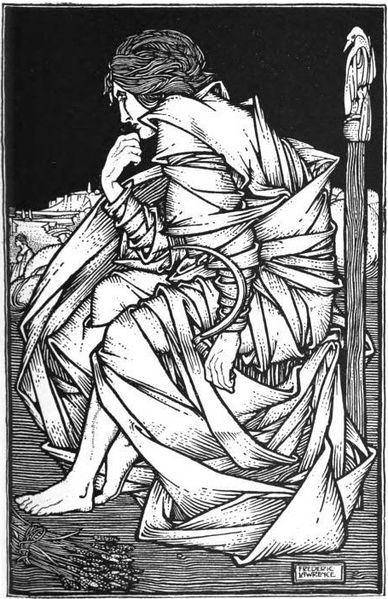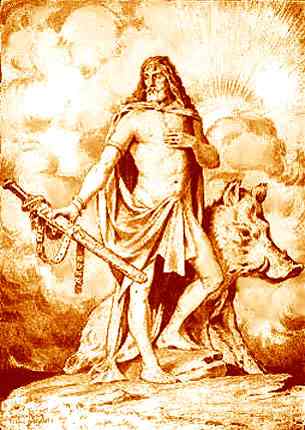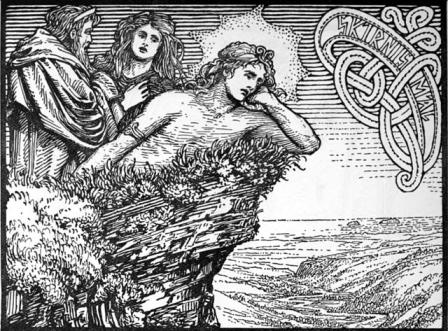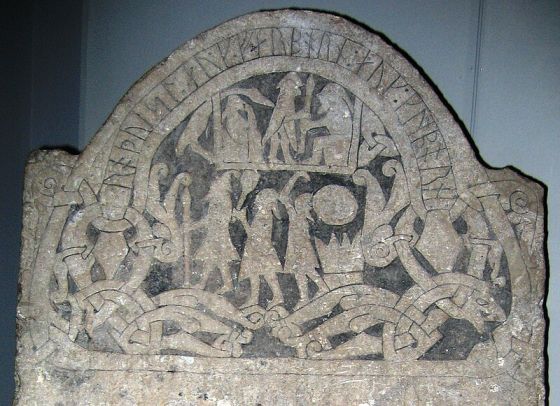In Norse mythology, Freyr is the god of fertility and prosperity, and closely associated with summer. He comes from the Vanir tribe of gods who were often portrayed as being more connected to nature and agriculture.
Freyr came to live among the Aesir in Asgard along with his father Njörd and sister Freyja after the Aesir-Vanir war. To avoid further bloodshed, both tribes of gods sent a few of their own to live with the other tribe. I have always found this origin story fascinating, and I believe it was likely not far removed from actual Viking Age customs among the clans. However, I have to add that it didn’t actually turn out so good for the Aesir “hostages”, but that is another story.
There are several other stories about Freyr that makes him both a uniquely brave warrior, as well as looking a bit like a love-sick puppy, if I’m to be honest. Again I think that his stories probably seemed relatable to people living in Scandinavia during the Viking Age.
Freyr Key Facts
| Parents | Njord and his sister-wife, possibly Nerthus |
| Partners | Gerdr |
| Siblings | Freyja |
| Offspring | Fjölnir |
| Tribe | Vanir |
| Old Norse name | Freyr |
| Other names | Lord, Ing, Yngvi |
| The God of | Fertility, Prosperity, and Peace |
| Ass. Animals & Artifacts | Gullinbursti (a boar), Skidbladnir (ship), Blóðughófi (his horse ‘Bloody Hoof’) and his sword |
Name and Etymology
The name “Freyr” in Old Norse, translates to “Lord” or “Master,” a title befitting his position among the gods. Interetingly closely associated with the meaning of his sister Freyjas’ name, which can be translated as “Lady”. So together the two Vanir siblings names were Lord and Lady.
I’m not sure if there was a deeper significance to the names, but it sort of seems likely that there might have been. Possibly there are parts of Freyrs’ backstory that we no longer know, positioning him as a ruler of sorts.
As Norse tales traveled and mingled with other cultures, the name underwent subtle transformations. In English, it’s often anglicized as “Frey,” a testament to the god’s widespread influence beyond the Nordic regions.

Kennings, those poetic metaphors so cherished in Norse poetry, often allude to Freyrs’ association witth agricultural abundance. Examples of these names are “God of the shining rain”, “God of the Fertile Season” and “Master of riches.” In an agrarian farmer world like that of Viking Age Scandinavia, I’m sure you could hope for nothing better than rain for your crops.
Ancient roots
In Norse mythology, you can trace many of the gods and the central concepts back to even older Germanic gods and myths. This is the case with Freyr as well, who was known as Yngvi, or Ing, in a mythology predating the Viking Age.
The name “Yngvi” is also closely associated with the legendary Swedish dynasty, the Ynglings, further emphasizing its historical significance. The dynasty, which claims descent from Freyr (Yngvi), showcases the god’s lasting legacy in both myth and historical lineage.
This is also a good example of how Norse mythology developed differently over time, and across the regions of Scandinavia. Today, most people look at Norse mythology as a fairly uniform belief system with set gods and myths etc. However that isn’t really how it was in the actual Viking Age. There were large regional differences, and the gods had different importance depending on the area.
Freyr’s Origins
As I mentioned already, Freyr isn’t an Aesir god, but he is from the Vanir tribe, who lives in Vanaheim. Typically seen as being closely connected to the natural world, and magic, the Vanir gods living in Asgard carries that with them.
As legend has it, there were originally four Vanir set to move to Asgard, not only Freyr, his sister Freyja and their father Njörd. The fourth one was their mother, Njörds wife, and sister, as it were. The Aesir however did not look kindly on such close family ties to a wife, and decided against her coming to Asgard. Anecdotally I think it’s fair to surmise that Freyr was only a baby when he moved to Asgard.
I will come back to this, but Freyr is the ruler of Alfheim, the home realm of the Elves, or Ljosálfr. The realm was given to him as a toothing-gift by the Aesir gods (when he had his first tooth). Based on this, and the whole Aesir-Vanir war, it seems this must have happened after the war, so around the time he moved to Asgard.
Thus, early in their stay in Asgasrd, Freyr and Freyja only had their then bachelor dad Njörd, as a parent, and no mother. Later though, they got a foster mother as Njörd married the jötun Skadi. While that marriage didn’t last, based on the story of Freyr and Gerdr, which was while Skadi still was his foster mother, she seems to have been married to Njörd well into Freyr and Freyjas adulthood.
Brother to Freyja
As mentioned already, Freyrs’ sister is the goddess Freyja. In modern literature, they are often said to be twins, however I can’t really ascertain that this was the case. Also, this doesn’t really fit if it is as I believe, that Freyr was a baby when he moved to Asgard.
Another much discussed theory out there is that the Aesirs’ treatment of Freyja, in the form of a Vanir woman called Gullveig, was the actual reason for the Aesir-Vanir war breaking out. If this is the case, Freyja would have had to be an adult before the war breaking out.
In Norse mythology you actually find a lot of these ‘inconsistencies’ where things don’t fit neatly into a timeline. If time is a flat circle, I am sure the Vikings were early adopters of this notion. Maybe both things could have been true, at different times prior to, or during the Viking Age. Then it’s only now, much later when we try to present everything as a set of beliefs that these ideas and theories slam into each other. I find that you just have to accept these slight differences ans part of the attraction of Norse mythology.
The Mystery of Freyr’s Mother
While we know that Freyr’s mother was Njord’s sister, her name remains shrouded in mystery. Two possible names do come up in various sources though, Nerthus and Njörun.
Njörun is mentioned various kennings found in the Prose Edda, written by Snorri Sturluson in the 13th century. It’s also easy to point to the similarities in the names of Njörd and Njörun, although the exact meaning of the name escapes us. However the -run ending in Njörun means secret, and several Old Norse names for girls are based on male names given a -run ending.
Another possible name for Freyr’s mother is Nerthus. Coming from the old Proto-Germanic *Nerþuz, the name is actually an early Germanic precursor to Njörðr. While it seems that Njörd in some version of the early story could in fact have been a femal goddess in older Germanic myths, it might just as well have been a name of his elusive sister. Again, it is unlikely we will ever know for sure, so I would caution anyone against stating one or the other as facts, rather they are interesting possibilities.
Freyr’s Family and Relationships
Freyr is mentioned in several sagas and myths, but most central of all is the poem Skírnismál, from the Poetic Edda. This poem goes into great detail about how Freyr and the beautiful jötun Gerdr ends up a happily married couple. Although a central story about Freyr, he doesn’t really play a large part. Relying as he was on his servant Skírnir to close the deal as it were.
Whaterver the circumstances regarding the “courting” of Gerdr, she ends up marrying Freyr and it seems to have been a happy union. Together, Freyr and Gerdr had one son named Fjölnir.
Fjölnir – King of the Ynglings
Their son Fjölnir actually shows up in a couple of ancient stories, both in the poem Grottasongr, and in the Saga of the Ynglings, found in Heinskringla, written by Snorri Sturluson. From both sources we learn that Fjölnir in fact lived out his days as a king in the important area Uppsala in Sweden. However, when I say he lived out his days, I should add that he met his actual end as he, dead-drunk fell into a giant cauldron of mead.
The Ynglings and Their Divine Ancestry
The Ynglings, the oldest known Scandinavian dynasty, proudly claimed their descent from Freyr, via his son Fjölnir. This assertion is meticulously documented in the Saga of the Ynglings. By aligning themselves with Freyr, the Ynglings not only elevated their royal stature but also intertwined their legacy with the divine. This divine ancestry was a testament to their right to rule; being descendants of a god associated with fertility and prosperity symbolized their ordained role as providers and protectors of their land and people.
The Ynglings’ claim to Freyr’s lineage underscores the god’s profound impact on both mythological and historical narratives. This likely also to a large extent explains why Freyr was such an important god in parts of modern day Sweden, much more so than for example in Norway.
Freyr’s Roles And Responsibilities
At the heart of Freyr’s roles or responsibilities associated with him was his role as the guardian of fertility. He was the force behind bountiful harvests, ensuring that the land yielded its riches and that people never faced the specter of famine.
Farmers would have invoked his blessings before sowing seeds, hoping for a prosperous season. However, his influence wasn’t limited to crops alone; he was also seen as a protector of livestock, ensuring their health and growth.
In the realm of the gods, Freyr was the ruler of Alfheim, as I mentioned, given to him as a gift when he was still a baby. We know very little about this, and Alfheim in general, but I suspect that there are several lost stories about this.
Bringer of Peace and Prosperity
Beyond just fertility, Freyr was revered as a deity of peace. In a time when skirmishes and battles were frequent, Freyr was believed to bestow peace and prosperity upon the lands, ensuring that communities thrived and lived harmoniously. .
Protector of Humanity
For mortals, Freyr was more than just a distant deity; he was a protector. Sailors would invoke his name before embarking on perilous journeys, seeking his protection from the unpredictable seas. Couples desiring offspring would offer prayers to him, hoping for his blessings in their quest for parenthood. However, this was as I mentioned likely much more so in parts of Sweden, than in other parts of Viking Age Scandinavia.
Freyr’s Enchanted Artifacts and Animals
Freyr, like many of the gods, had several different more or less magical objects or animals. A couple of his posessions actually came to him after bet between Loki and a couple of master dwarf craftsmen.
Gullinbursti – The Golden Boar

Gullinbursti, which translates to “Golden Bristles,” was a magnificent boar created by the skilled dwarven brothers, Brokk and Sindri. This radiant boar, made from gold, was not just a symbol of Freyr’s dominion over fertility and prosperity but also an embodiment of the sun’s life-giving rays. With its golden bristles shining brighter than the sun, Gullinbursti could run through air and water faster than any horse, making it a formidable companion for Freyr.
Skíðblaðnir – The Magical Ship
Skíðblaðnir, another marvel from the same dwarven duo, was a ship like no other. Despite its vast size, capable of holding all the gods with their war gear, it could be folded up like a piece of cloth and carried in one’s pocket. This ship, always blessed with favorable winds, further symbolized Freyr’s mastery over prosperity and abundance. Ensuring that those under his protection always found their way to bountiful shores.
The Self-Wielding Sword
Freyr’s sword was another masterpiece of enchantment. It had the ability to fight on its own “if wise be he who wields it,” as the sagas describe it. This sword, however, was given away by Freyr in his pursuit of Gerdr’s love, a sacrifice that would later have significant consequences during Ragnarök. The act of parting with such a powerful weapon for love further emphasizes Freyr’s character, showcasing his values and the lengths he would go to for his heart’s desires.
Blóðughófi – The Steed of Distinction
Blóðughófi, or “Bloody Hoof,” was Freyr’s horse. As mentioned in Nafnaþulur, Freyr chose this horse for his journeys, likely a testament to the steed’s unmatched speed and strength. The very name “Bloody Hoof” evokes images of a horse that has traversed countless battlefields, perhaps symbolizing Freyr’s unwavering determination and resilience.
Play Fun Norse Quiz
Is this article making you even more curious about Norse gods and goddesses? You can satisfy your curiosity by playing a fun Norse mythology quiz. This way, you can test your knowledge about Norse gods and goddesses, as well as fill in some gaps. Good luck and have fun playing!
Don’t forget to try our other games as well!
Myths about Freyr
There aren’t that many stories found in Norse mythology where Freyr plays a large part. Interestingly, he doesn’t even play the main part in the story of how Gerdr is talked into marrying him.
Freyr and Alfheim: The Tooth-Gift
When Freyr was just a child, the gods bestowed upon him the realm of Alfheim as a “tooth-gift” – a customary gift given to a child upon the growth of their first tooth. Alfheim, known as the land of the Light Elves, is a realm of beauty, peace, and prosperity. This gift was not just a testament to Freyr’s importance among the gods but also a foreshadowing of his future role as the deity of fertility and abundance. Under his rule, Alfheim flourished, reflecting the prosperity and growth that Freyr brought to everything he touched.
Just like Vanaheim however, we don’t know that much about Alfheim. I do believe this was much better known way back when, and that this has been lost in the passage of time.

The Wooing of Gerdr – A Tale of Love and Persistence
One of the most iconic tales associated with Freyr is sudden and deep love for the beautiful jötun maiden Gerdr. Sitting one day in Odin’t seat Hlidskjalf, Freyr saw deep into the realm of Jotunheim. There he saw a beautiful young jötun maiden and he fell madly in love with her at first sight.
Forlorn and unsure of himself, he can not muster the courage to travel to her and try to woo her himself. Instead he ends up sending his servant, a man named Skirnír, to try to convince Gerdr of becoming Freyr’s wife.
Skirnir, armed with Freyr’s own sword and a few magical artifacts, ventured into Jotunheim. Once there, through a combination of promises, quite graphic and creative threats, and enchantments, Skirnir finally secured Gerdr’s consent for a meeting with Freyr and it ends in their marriage.
I always liked the Skirnismal for the rather inventive and graphic threats Skirnir uses to convince Gerdr of marrying Freyr. You should go read it if you haven’t to understand what I mean. I can’t help but think that the story also went far in explaining, and maybe justifying arranged marriages in Norse society.
Ragnarok – The God Without His Sword
The tale of Freyr’s sacrifice for love comes full circle during the cataclysmic events of Ragnarok. Having given up his magical sword in his quest to win Gerdr’s heart, Freyr faced the fire giant Surtr unarmed. This selfless act, while showcasing his depth of love and bravey, also sealed his fate. Without his sword, Freyr was overpowered by Surtr, marking the fall of one of the most revered Vanir gods, and possibly sealing the fate of the world.
Mentions in Ancient Texts
Freyr is mentione in several of the well known Norse texts. The Prose Edda, written by the historian Snorri Sturluson, and the Poetic Edda, a collection of poems by unknown authors, are the best known.
Prose Edda

When Snorri Sturluson wrote his books in 13th century Iceland, the indigenous Germanic gods, though no longer openly worshiped, were still vividly remembered. Their tales had endured for over two centuries, and Freyr’s story was no exception.
Gylfaginning
In the Gylfaginning section of his Prose Edda, Snorri introduces Freyr as a major deity:
“Njördr in Nóatún begot afterward two children: the son was called Freyr, and the daughter Freyja; they were fair of face and mighty. Freyr is the most renowned of the Æsir; he rules over the rain and the shining of the sun, and therewithal the fruit of the earth; and it is good to call on him for fruitful seasons and peace. He governs also the prosperity of men.” – Gylfaginning XXIV, Brodeur’s translation
This portrayal shares similarities with an older account by Adam of Bremen. While Adam attributes control of weather and field produce to Thor, Snorri assigns these roles to Freyr. Such discrepancies could arise from different writing objectives, regional variations in Norse and Swedish paganism, or potential distortions in the information available to either Adam or Snorri.
The most extensive myth about Freyr in the Prose Edda revolves around his marriage. After glimpsing the beautiful giantess Gerðr, Freyr falls deeply in love. His ensuing melancholy and taciturnity concern those around him. Upon revealing the cause of his distress, he sends his servant Skírnir to woo Gerðr on his behalf. The tale unfolds with Skírnir’s journey, the challenges he faces, and the eventual union of Freyr and Gerðr.
Freyr’s loss of his sword, a consequence of his quest for love, has significant implications. While he manages to defeat the giant Beli using an antler, the absence of his sword proves fatal during Ragnarök, where he meets his end at the hands of the fire-giant Surtr.
Poetic Edda
Freyr’s tales also find mention in the Poetic Edda, a collection that offers insights consistent with the Prose Edda but also introduces unique details.
Völuspá
In Völuspá, the final confrontation between Freyr and Surtr during Ragnarök is depicted:
“Surtr moves from the south with the scathe of branches: there shines from his sword the sun of Gods of the Slain. Stone peaks clash, and troll wives take to the road. Warriors tread the path from Hel, and heaven breaks apart.” – Völuspá 50–51, Dronke’s translation
Grímnismál
Grímnismál provides miscellaneous details about the gods, including Freyr’s abode, Alfheim, gifted to him as a tooth-gift. The poem also mentions Freyr’s ship, Skíðblaðnir, and his boar, Gullinbursti.
Lokasenna
In Lokasenna, Loki, the trickster god, levels accusations against the gods. He points out the incestuous relationships among the Vanir, hinting at Freyr’s relationship with his sister, Freyja. Despite these accusations, the god Týr defends Freyr’s honor.
Skírnismál
Skírnismál delves deeper into the courtship of Freyr and Gerðr. It portrays Freyr’s profound sorrow upon seeing Gerðr and his subsequent plea to Skírnir to woo her. The poem beautifully captures the challenges, emotions, and eventual union of the two lovers.
Frequently Asked Questions
Gerdr, a beautiful giantess, is Freyr’s most notable partner.
Freyja is Freyr’s twin sister, and both are prominent figures in the Vanir tribe.
The golden boar, Gullinbursti, is closely associated with Freyr.
Yes, Freyr had a ship named Skíðblaðnir and a magical sword.
Freyr met his end at the hands of the fire giant Surtr during Ragnarok.
